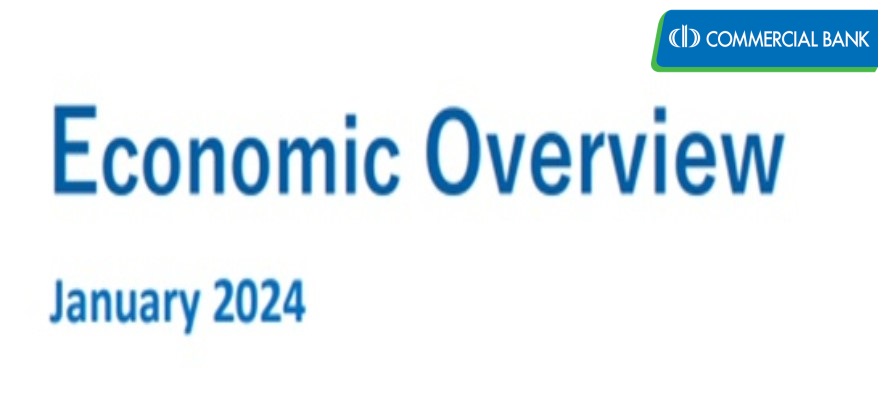Economic Overview: January 2024

Economy
63 week ago — 11 min read
Macroeconomic Overview
• Services exports record an impressive growth in 2023
• In relation to apparel exports, it is important to explore untapped markets in Eastern Europe, the Middle East and East Asia.
An improvement in economic fundamentals in 2023
An improvement in economic fundamentals could be observed in 2023. After nearly two years of recession, the GDP growth rate for the third quarter of 2023 recorded a positive 1.6 %. Inflation, which peaked at 69.8 % in September, 2022, came down gradually to record below 5%. The interest rates too have come down after recording very high levels. The prime lending rate had come down to around 12% by December, 2023 after recording a high level of 29.7% in November, 2022. The exchange rate stabilized below Rs.330 per USD and ended 2023 at Rs. 323.98 per USD. The rupee further strengthened to record Rs.321.89 per USD on the 2nd of January, 2024. The gross official reserves have also strengthened. With the receipt of the second tranche under the IMF-EFF program (around USD 337 mn) Gross Official Reserves (GOR) recorded USD 4.4 bn at end 2023. The GOR also includes USD 220 mn received from the ADB and USD 250 mn received from the Word Bank. There has also been an improvement in government revenue. For 2023, government revenue recorded Rs. 3.1 trn (11.2% of GDP) as against a revised estimate of Rs.2.85 trn. The projections are to increase government revenue to 15% of GDP by 2025. The country has also witnessed a noteworthy increase in the number of tax files, from 437,547 in 2022 to a significant milestone of around one million as at present (Government sources/CBSL). Further, the official unemployment rate had fallen to 4.7% in the third quarter of 2023 from 5.2% recorded in the previous quarter in line with the recovery seen in the overall economic growth (DCS).
Worker remittances
As per the Central Bank (CBSL) data, Sri Lanka’s workers’ remittance inflows in 2023 amounted to USD 5.97bn, up by 57.5 % compared to 2022. The pace of recovery in official workers’ remittance inflows to Sri Lanka witnessed during 2023 is unlikely to continue in 2024 amid possible low oil prices resulting in fewer new employment opportunities in the key Gulf region, according to the World Bank (WB - latest Migration and Development Brief)
Tourism
Earnings from tourism in Sri Lanka for 2023 recorded USD 2.07 bn, which is an 82% growth compared to 2022. (CBSL) In terms of tourist arrivals, Asia and the Pacific reached 62% of pre-pandemic levels during January - September, 2023 due to slower reopening to international travel. However, performance among sub-regions is mixed, with South Asia recovering 95% of pre-pandemic levels but North-East Asia only about 50%. (UNWTO World Tourism Barometer) Against this backdrop, international tourism is well on track to fully recover to pre-pandemic levels in 2024 despite economic challenges such as high inflation and weaker global output, as well as geopolitical tensions and conflicts. (UNWTO World Tourism Barometer)
Services exports
The value of services exports in Sri Lanka is estimated to have increased by 68.7% to USD 2.9 Bn in the first 11 months of 2023 compared to the corresponding period in 2022. The services exports estimated by EDB consist of ICT/BPM, construction, financial services and transport and logistics. The value of ICT exports is estimated to have increased by 47.9 % to USD 1.52 Bn in the first 11 months of 2023 compared to the corresponding period in 2022. (EDB)
Outlook for the future
The current account of the BoP is estimated to have recorded a surplus in 2023. However, it remains to be seen how the BoP will turn out in 2024 when most imports, including vehicles, are relaxed in a likely recovering economy where people and businesses will raise their demand for imported goods and services amid easier access to credit. It also remains to be seen when the debt repayments under external debt restructuring would commence as it could also apply additional pressure on the BoP due to mounting outflows.
The outlook for exports remains grim as of now, as the West is largely expecting an economic slowdown - a so-called ‘soft-landing’- where the inflation returns to its target level of 2% without causing a recession.
Sri Lanka’s exporters face a 40-50% hike in freight rates and space shortages, as global shipping companies move to reroute their vessels around the Cape of Good Hope in a bid to avoid disruption to shipments after the recent attacks on vessels in the Red Sea by the Yemeni Houthi militant group. However, the freight rates remain low compared to one and a half years ago. Before this recent surge, the freight rates were only 10% of what it was one and a half years ago, according to industry sources. (Nishal Fernando)
USA is one of the key export markets of the apparel industry in Sri Lanka. In USA, inflation has cooled dramatically, unemployment remains low and the Federal Reserve could deliver rate cuts as soon as March-May, 2024. These developments provide some hope for Sri Lanka’s apparel exports at a time when the industry is facing low demand from its key export markets.
The United States, United Kingdom and India remain the largest export markets for Sri Lanka. In relation to apparel exports, it is important to explore untapped markets in Eastern Europe, the Middle East and East Asia. [Sri Lanka Chamber of Garment Exporters (SLCGE)
The VAT rate was increased to 18% from 15% with effect from 1st January, 2024. This is in addition to the removal of VAT exemptions from 98 items out of 140. The VAT threshold too has been reduced to Rs. 60 mn from Rs. 80 mn.
As a result of these changes in relation to VAT, the cost of living is expected to increase by around 3-5%. Further, the reduction of the buying power of the consumers due to the changes in relation to the VAT, will lead to a drop in demand for relevant goods and services, thereby adversely affecting domestic production of those goods and services. Additionally, the increase in capital costs will have an adverse impact on capital investments.
Making the renewable energy producing equipment liable to VAT will have an adverse impact on potential investments in the renewable energy generation sector.
In many countries, VAT revenue amounts to between 6-8% of the Gross Domestic Product (GDP). However, in Sri Lanka, the VAT revenue for 2023 was estimated at 2.2% of GDP. The expectation is to increase VAT revenue to around 4% of GDP in 2024. [Source: Director General of the State Revenue Unit of the President’s Office, (SRU PO) M. J. Gunasiri].
Climate change: The El Nino phenomenon, caused by warmer waters in the Pacific ocean, will produce erratic weather that could cost the world economy USD 3 trn. Although El Nino should recede by mid-2024, it threatens to cut crop yields in Africa, Asia and Central America. A cut in crop yields could also disturb hopes of falling inflation. (Source: The World Ahead 2024 – The Economist).
In Sri Lanka, a severe drought is predicted between February and the middle of 2024 posing a threat to the country’s food security, especially at a time when people endure hardships due to the economic crisis. Shifts in climate can lead to altered growing seasons, changes in the prevalence of pests and diseases and increased risk of crop failures. Sri Lanka is already a country vulnerable to climate changes with frequent extreme weather events such as floods, droughts and storms that could damage crops and disrupt supply chains. [Source: Assistant Representative of the Food and Agriculture Organization (FAO) Nalin Munasinghe].
Interest Rates & Exchange Rate
At the T-bill auction held on 23rd January, 2024 yields of 91 day t-bills decreased to 13.35% from 13.91% a week ago (-56bps) while yields of 182 day t-bills dropped to 13.41% from 13.83% a week ago (-42bps). The 364 day t-bill yield dropped to 12.78% from 12.92% (-14bps).
Meanwhile Rs 130bn worth bills were offered at the auction and the same was sold.
CBSL purchased USD 113mn worth dollars from commercial banks on a net basis during December 2023. For year 2023, CBSL purchased USD 1.75Bn worth dollars from commercial banks on a net basis.
The Central Bank middle rate recorded Rs.319.88 per US dollar as of 24 January 2023
Global Outlook
- China’s economy grew by 5.2% in 2023, just above the government’s target of 5%. However, the figure is a comparison with the low base of 2022, when GDP expanded by just 3% because of pandemic restrictions. China’s population also fell in 2023 for the second year, by 2m people to 1.409bn
- German GDP was 0.3% smaller in 2023 than the previous year, as higher prices hit household consumption and trade. The economy may have avoided a recession in the second half of the year.
- Consumer prices in the US rose in December, driven by higher costs for housing, dining out and car insurance. Inflation hit 3.4% in December 2023, the Labour Department said.
- Britain recorded an unexpected rise in inflation. The annual rate rose to 4% in December, the first increase in ten months. Coming after a surprise increase in America’s inflation rate (to 3.4% in December) and a rise in the euro zone’s (to 2.9%) investors are pushing back their estimates of when central banks will cut interest rates. Christine Lagarde, president of the European Central Bank, hinted this week that the ECB won’t start reducing rates until the middle of 2024.
- Argentina has announced that it will not join the BRICS bloc of developing economies, fulfilling a campaign promise by newly elected far-right President Javier Milei who has pledged to pursue closer ties with the West.
- Oil prices settled lower on 23 Jan as traders focused on rebounding crude output in parts of the U.S., along with rising supply in Libya and Norway, rather than risks to supply posed by conflict in Europe and the Middle East. Brent crude settled at USD 79.55 a barrel
Dr. Shanthikumar Fernando Research & Development Unit shanthikumar_fernando@combank.net
Disclaimer: This document has been issued for the information of the customers of Commercial Bank of Ceylon PLC only. The Bank and its employees do not accept any responsibility for the accuracy or completeness of the contents and any losses arising from any use of this material.
View Commercial Bank 's profile
Other articles written by Commercial Bank LEAP Team
Economic Overview: December 2023
68 week ago
Most read this week
Trending
The Art & Science of People Pleasing in Retail
Retail 14 week ago












Comments
Share this content
Please login or Register to join the discussion